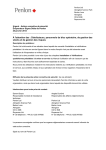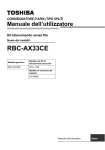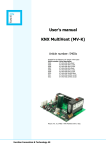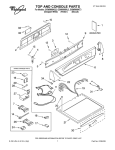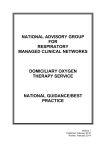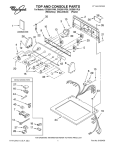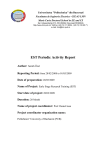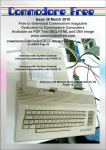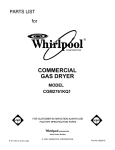Download "user manual"
Transcript
Anaesthesia, 1997, 52, pages 668–672 ................................................................................................................................................................................................................................................ A P PA R AT U S The Oxyvent An anaesthetic machine designed to be used in developing countries and difficult situations R. J. Eltringham1 and A. Varvinski2 1 Gloucestershire Royal Hospital, Great Western Road, Gloucester GL1 3NN, UK 2 Archangelsk Medical Academy, Troytski 51, Archangelsk 163061, Russia Summary The Oxyvent is an anaesthetic machine designed specifically for use in the developing world and difficult situations. It is made up of four components, each of which has, in its own right, already proved to be of great value in difficult situations. These are the drawover system, the Penlon Manley Multivent Ventilator, the DeVilbiss Oxygen Concentrator and the air compressor. The four components are mounted on a simple trolley carrying two oxygen cylinders. The Oxyvent can be used to provide anaesthesia in the absence of electricity or oxygen or both. It is simple, robust and easily serviceable. It is versatile and can be used both as an anaesthetic machine in the operating theatre and as a ventilator in an intensive care unit. Keywords Equipment; anaesthesia machine, drawover system, compressor, oxygen concentrator, ventilator. ...................................................................................... Correspondence to: Dr R. J. Eltringham Accepted: 6 February 1997 In many regions of the world anaesthetics are administered by health workers with limited training, unreliable supplies and inadequate and poorly serviced equipment. The design of an anaesthetic machine suitable for use in these circumstances is therefore very different from one intended for use in the UK, for example, where adequate facilities are taken for granted. Such a machine must be robust, easy to understand and operate, require minimal maintenance and be readily serviceable using local skills. It should also be versatile so that it can be used whatever anaesthetic agents and equipment are available at the time and should be capable of functioning if either the supply of compressed gases or electricity are interrupted [1]. It can readily be appreciated that the modern, sophisticated machines currently used in most hospitals in this country are totally unsuitable and why attempts to introduce them into developing countries have usually been expensive failures. When the first fault arises they are generally discarded and consigned to the graveyard of anaesthetic apparatus gathering dust in store rooms around the world [1]. This article describes the Oxyvent, an anaesthetic 668 machine which has been designed specifically for use in difficult situations. It fulfils all the above requirements and can make a considerable contribution towards safer anaesthesia in difficult environments. The Oxyvent is made up of four components each of which has, in its own right, already proved to be of great value in difficult situations. These are, the Drawover System [1–4], the Penlon Manley Multivent Ventilator [5–8], the DeVilbiss Oxygen Concentrator [9, 10] and the air compressor [1, 2]. In the Oxyvent, the DeVilbiss Oxygen Concentrator has been modified so that it can also function as a compressor and has been mounted together with the other two components on a simple metal trolley which has two shelves, an electrical socket and cradles for two 600-l oxygen cylinders at the rear (Figs 1 and 2). The Drawover Anaesthesia system This system enables inhalational anaesthesia to be administered in the absence of a supply of compressed gases, atmospheric air being used as the carrier gas. Various forms of drawover apparatus have previously Q 1997 Blackwell Science Ltd Anaesthesia, 1997, 52, pages 668–672 R. J. Eltringham and A. Varvinski • The Oxyvent ................................................................................................................................................................................................................................................ Figure 1 The Oxyvent viewed from the front. The Penlon Figure 2 The Oxyvent viewed from the rear. Cradles contain- Manley Multivent ventilator is on the upper shelf with the OMV vaporiser and reservoir tube on the right side. The DeVilbiss Oxygen Concentrator is on the lower shelf. The oxygen flow knob is situated below the flow meter in the centre of the concentrator. Next to this is the oxygen outlet which is connected by tubing to the reservoir tube. On the right of the concentrator is the compressed air outlet. ing the oxygen cylinders are on either side of the trolley. Electrical sockets are situated between the cylinders. been described [2], but the essential features of each are: a calibrated vaporiser with a sufficiently low resistance to allow spontaneous respiration, a means of giving positive pressure ventilation such as a self-inflating bag or bellows with a valve to prevent the gas mixture from re-entering the vaporiser and a unidirectional valve at the patient’s airway to direct expired gases into the atmosphere to prevent rebreathing. In the Oxyvent, modifications of both the Oxford Miniature Vaporiser (OMV) [11] and the Oxford Inflating Bellows (OIB) [3] are used. The inspired mixture can be supplemented by oxygen from the first of the two cylinders delivered to an open-ended reservoir tube via a T piece upstream of the vaporiser [12]. The oxygen flow is controlled by a Houtonox oxygen regulator at either 1 or 4 l.minÿ1 according to Q 1997 Blackwell Science Ltd the patient’s requirements as used in the Triservice apparatus [11]. The Penlon Manley Multivent ventilator This is a mechanical version of the Oxford inflating bellows [5]. The driving force required to expand the bellows can be any gas source at a pressure of at least 140 kPa, such as a standard oxygen cylinder. The second oxygen cylinder is connected via a regulator to the driving gas inlet at the rear of the ventilator for this purpose. A weighted beam attached to the top of the bellows is driven upwards around a fulcrum by the compressed gas acting on a linear thruster. This causes the bellows to expand drawing into it the inspired gas mixture. When it has reached the required height, as determined by the tidal volume setting, the weighted beam descends compressing the bellows and delivering the gas mixture to the patient. The inspiratory pressure can be adjusted to a maximum of 669 R. J. Eltringham and A. Varvinski • The Oxyvent Anaesthesia, 1997, 52, pages 668–672 ................................................................................................................................................................................................................................................ 4.9 kPa according to the compliance of the patient’s lungs by varying the position of the weight. A handle on the end of the beam enables the bellows to be operated manually if the driving gas supply fails. The ratio of the linear thruster to the bellows has been set so that the volume of driving gas required is only 1/10th of the minute volume set for the patient [5]. For example, at a minute volume of 6 l.minÿ1 only 600 ml.minÿ1 of the driving gas is required. It is therefore much more economical than other gas-driven ventilators [13, 14]. A single 600-l oxygen cylinder when used in this way can last for 16 h. When oxygen is being used as the driving force, even further economies are possible since the oxygen used to elevate the beam can subsequently be used to supplement the inspired gas mixture. This is achieved by connecting the driving gas outlet situated on the side of the ventilator to the reservoir tube (Fig. 3). In other words, the oxygen is used twice, first of all to expand the bellows and subsequently to increase the FIO2. Values of 30–40% are produced regardless of the minute volume delivered, without the need for supplementation from an additional source [15]. If oxygen is unavailable to drive the ventilator then compressed air can be used as an alternative source of power, either from a compressor or from a cylinder. In this case of course, the FIO2 cannot be increased by the addition of the driving gas to the reservoir tube as before and a separate source of oxygen is needed for this purpose. The Penlon Manley Multivent Ventilator is simple, robust and easily serviceable. There are only three controls, tidal volume, respiratory rate and I:E ratio, so that it is easy to understand and operate. If ether is the anaesthetic agent in use, an alternative version, in which the electronic circuit is separated from the gas mixture by a distance of 25 cm to eliminate the possibility of an explosion, is available. It is extremely versatile, can be used with any anaesthetic breathing system [5] and does not require a continuous supply of electricity. By utilising a rechargeable battery incorporated within the casing it can continue to function for up to 48 h without interruption in the event of a failure of the electricity supply. It has been thoroughly tested in a variety of clinical situations and shown to be reliable [6, 7]. The Modified DeVilbiss Oxygen concentrator The standard version of the DeVilbiss Oxygen Concentrator (MC44) has been used for many years as a source of oxygen both for domestic use [16] and in the operating theatre [9, 10]. Its function depends on the ability of zeolite granules to absorb nitrogen from compressed air. It consists of an air inlet, a series of filters and a compressor which produces a supply of compressed air at 140 kPa. This is then directed into the first of two canisters containing zeolite, in which the nitrogen is absorbed and the residual oxygen passed to the patient (Fig. 4). After <10 s the supply of compressed air is automatically diverted to the second canister where the process is repeated and the flow of oxygen continues uninterrupted. While the pressure in the second canister is 140 kPa the pressure in the first canister is reduced to atmospheric pressure, the nitrogen released into the atmosphere and the granules of zeolite recharged ready for the next cycle. By alternating the supply of compressed air between the canisters a continuous supply of oxygen at a concentration of 90% can be produced at flows of up to 5 l.minÿ1 . Routine maintenance can be undertaken using local Figure 3 The OMV vaporiser is connected directly to the gas inlet port on the right-hand side of the ventilator. Oxygen can be delivered from the driving gas outlet on the ventilator to the reservoir tube upstream of the vaporiser by the tube passing in front of the vaporiser. 670 Q 1997 Blackwell Science Ltd Anaesthesia, 1997, 52, pages 668–672 R. J. Eltringham and A. Varvinski • The Oxyvent ................................................................................................................................................................................................................................................ Figure 4 Schematic diagram of the standard DeVilbiss Oxygen Concentrator. skills and principally consists of changing the filters according to the manufacturer’s recommendations. There is a built-in oxygen analyser which sounds an alarm if the oxygen concentration decreases below 70%. This usually indicates that the filters need to be changed. In the Oxyvent a modification of the standard version of the concentrator is used (Figure 5). This version provides, in addition to the oxygen, a source of compressed air which can be used to drive the ventilator in the absence of cylinder oxygen. This has been achieved by syphoning off some of the compressed air before it reaches the zeolite canisters and diverting it to a second outlet on the front of the Oxygen Concentrator. This can then be fed directly into the driving gas inlet of the ventilator via high-pressure tubing [15]. In this way an alternative source of power is automatically built into the Oxyvent at no extra cost, obviating the need for a separate source of compressed air. In order to eliminate delays when changing from one source of driving gas to the other, both the oxygen from the second cylinder and the compressed air from the concentrator are connected by a T piece to the driving gas inlet (Fig. 6). If electricity is available, compressed air from the concentrator is normally used as the driving force in order to conserve oxygen. In this case the FIO2 is supplemented via the reservoir tube by oxygen from the oxygen concentrator [15, 17]. If the supply of electricity is interrupted, the flow of compressed air ceases and the low-pressure alarm sounds on the ventilator. The second oxygen cylinder is then turned on to maintain power to enable ventilation to continue uninterrupted. In this situation the F IO2 is enhanced from the driving gas outlet as described above. If, on the other hand, the oxygen supply fails and electricity remains available, the process is carried out in reverse. In the event of neither oxygen nor electricity being available anaesthesia can still be administered safely using air as the carrier gas. In this case ventilation should be assisted or controlled by manually operating the bellows [3, 5, 11]. The upper shelf of the Oxyvent supports the Manley Multivent to which is connected the OMV and reservoir tube. The lower shelf supports the modified DeVilbiss oxygen concentrator. The cradle at the rear of the Oxyvent supports the two oxygen cylinders. Conclusion The Oxyvent represents an important advance in the safety of the administration of anaesthesia in difficult situations. The four components enable it to be used in any of the situations likely to be encountered in the developing world [1]. It is simple, robust and easily serviceable. It is also versatile and can be used in the operating room with any breathing system [5], on any size of patient [7] or it can be used as a ventilator in an intensive care unit. Most important of all it can continue to function in the event of interruption in the supply of either oxygen or electricity or both, situations which are all too frequently encountered in the developing world. The Oxyvent is available from Penlon Ltd of Abingdon, OX14 3PH. Figure 5 Schematic diagram of the modified DeVilbiss oxygen concentrator showing the additional compressed air supply for the ventilator. Q 1997 Blackwell Science Ltd 671 R. J. Eltringham and A. Varvinski • The Oxyvent Anaesthesia, 1997, 52, pages 668–672 ................................................................................................................................................................................................................................................ Figure 6 The rear of the Penlon Manley Multivent ventilator showing both oxygen and compressed air connected to the driving gas inlet by a T piece. Acknowledgments We acknowledge the assistance of Philip Ottoway of DeVilbiss Health Care and Craig Thompson of Penlon Ltd in the preparation of this paper, and Christina Finch for typing the manuscript. References 1 Ezi-Ashi TI, Papworth DP, Nunn JF. Inhalational anaesthesia in developing countries 1. The problem and the proposed solution. Anaesthesia 1983; 38: 729–35. 2 Ezi-Ashi TI, Papworth DP, Nunn JF. Inhalational anaesthesia in developing countries 2. Review of existing apparatus. Anaesthesia 1983; 38: 736–47. 3 Boulton TB. Anaesthesia in difficult situations (3). General anaesthesia technique. Anaesthesia 1966; 21: 513–45. 4 Farman JV. Anaesthesia and the EMO System. London: English University Press, 1973. 5 Manley R. A new ventilator for developing countries and difficult situations. World Anaesthesia Newsletter 1991; 5: 10–11. 6 Tindimwebwa VB, Mijumbi C. Preliminary clinical experience with the Manley Multivent in Mulago Hospital, Uganda. World Anaesthesia Newsletter 1992; 7: 5. 7 Eltringham RJ, Khuwaja A. Progress with the Manley Multivent. World Anaesthesia Newsletter 1993; 10: 6–8. 672 8 Shrestha BM, Amatya R, Basnyat MB, Singh BB, Lekak BD, Gurung A. The Penlon Multivent in Nepal. World Anaesthesia Newsletter 1995; 13: 10–11. 9 Fenton PM. The Malawi anaesthetic machine (experience with a new type of anaesthetic apparatus for developing countries). Anaesthesia 1989; 44: 498–503. 10 Pederson J, Nyrop M. Anaesthetic equipment for a developing country. British Journal of Anaesthesia 1991; 66: 264–70. 11 Houghton IT. The Triservice anaesthetic apparatus. Anaesthesia 1981; 36: 1094–108. 12 Mackie AM. Drawover anaesthetic systems. Anaesthesia 1987; 42: 299–304. 13 Penlon AV 600 Anaesthesia Ventilator. User Manual. Penlon Ltd, 1996. 14 Penlon Ventilator Series 200. User’s Instruction Manual. Penlon Ltd, 1996. 15 Eltringham R. Further experience with the Penlon Manley Multivent ventilator. Its use with the modified DeVilbiss Oxygen Concentrator. World Anaesthesia Newsletter 1994; 11: 10–11. 16 Cooper CB, Waterhouse J, Howard P. Twelve year clinical study of patients with hypoxic cor pulmonale given long term domiciliary oxygen therapy. Thorax 1987; 42: 105–10. 17 Jarvis DA, Brock-Utne JG. Use of an oxygen concentrator linked to a drawover vaporizer (anesthesia delivery system for underdeveloped nations). Anesthesia and Analgesia 1991; 72: 805– 810. Q 1997 Blackwell Science Ltd





